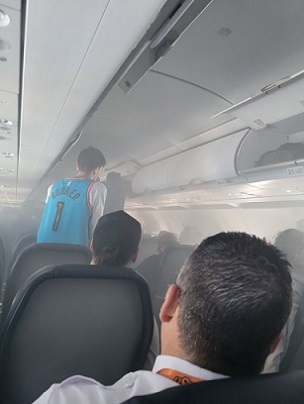 A lithium battery fire incident on board a passenger plane
A lithium battery fire incident on board a passenger plane
 An AvSax lithium battery fire mitigation bag which is now on almost 17,000 passenger aircraft worldwide
An AvSax lithium battery fire mitigation bag which is now on almost 17,000 passenger aircraft worldwide
A committee in the USA wants regulations on how lithium batteries can be safely transported on aircraft to be enforced worldwide as fears grow over the danger they pose.
The Lithium Battery Air Safety Advisory Committee will meet in Washington on November 2 and wants to ensure its rules are being followed.
The meeting comes after the Pipeline and Hazardous Materials Safety Administration said recently: “The safe transport of lithium batteries by air has been an ongoing concern due to the unique challenges they pose to safety in the air transport environment.
“Unlike most other hazardous materials, lithium batteries have a dual hazard of chemical and electrical. This combination of hazards, when involved in a fire, has the potential to create a scenario that exceeds the fire suppression capability of an aircraft and lead to a catastrophic failure of the aircraft.”
In short, fire suppression systems in aircraft luggage holds may well struggle with the intense heat generated by a lithium battery fire which is why USA regulations insist that all electronic devices such as mobile phones, iPads and laptops must be taken into the passenger cabin.
When a lithium battery overheats it goes into a chemical process called thermal runaway and when this happens one cell in a battery can produce enough heat – up to 900°C (1652°F) – to cause adjacent cells to overheat. This can cause a lithium battery fire to flare repeatedly and they are then very difficult to put out.
If the device is in the passenger cabin it means the crew can react quickly to deal with the fire. Almost 17,000 aircraft worldwide – including some of the biggest names in the industry - now carry AvSax lithium battery fire mitigation bags on board to deal with the problem quickly and effectively.
One of the main items on the Lithium Battery Air Safety Advisory Committee agenda is to advise and recommend activities to improve the global enforcement of US regulations and the International Civil Aviation Organization (ICAO) Technical Instructions relevant to air transportation of lithium batteries and the effectiveness of those regulations.
In the UK the Civil Aviation Authority says ICAO insists on cooling within a bag and AvSax is the only one that provides constant cooling once the overheated device has been put in there.
In its guidance the CAA states: “Since the development of the International Civil Aviation Organization guidance on dealing with an in-flight battery fire, new products designed for use in response to lithium battery thermal runaway events have become available.
“Products which provide both a cooling and containment capability are typically more aligned to the existing ICAO guidance as when used they are filled with water or other non-flammable liquid to act as a cooling agent.
“After knocking down flames it could conceivably take just a couple of seconds for a personal electronic device to be placed inside a containment bag, allowing it to be moved to a place of safety.
“Passengers could then return to their seats, mitigating potential unrelated safety hazards such as injury in the case of severe turbulence. Equally, the effect on flight crew in carrying out their duties following an event on the flight deck would be minimised.”
For more information on AvSax go to www.avsax.com